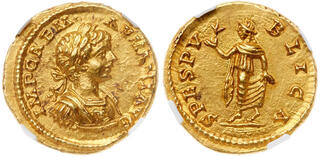| Dmitry Markov Coins & Medals | M&M Numismatics Ltd > Auction 60 | Auction date: 9 January 2024 |
| Lot number: 263 Price realized: 41,000 USD (Approx. 37,552 EUR) Note: Prices do not include buyer's fees. | Show similar lots on CoinArchives Find similar lots in upcoming auctions on |
| Lot description: Caracalla. Gold Aureus (7.14 g), AD 198-217 Laodicea ad Mare, AD 198. IMP CAE M.-AVR ANT AVG, youthful, laureate, and cuirassed bust of Caracalla right, aegis on the breastplate. Reverse: SPES PV-BLICA, Spes advancing left, holding a lily, and raising the hem of her stola. RIC 333 (R2); BMC 646 and pl., 43, 18 (same dies); Calicó 2821 (this coin). Very Rare. NGC grade MS*; Strike: 5/5, Surface: 5/5. Fine style. Ex Heritage "CICF World and Ancient Coins Signature Auction" (10 April 2014), 23621; Andre Constantine Dimitriadis Collection (Sotheby's, Zürich, 26 October 1993), 106; NFA XX (9 March 1988), 271; "Collection of a Deceased Nobleman, formed before the Great War" (Sotheby's, Zürich, 28 November 1986), 106; Bruder Egger, Vienna, (20 April 1904), 194. Spectacular Ex Egger Collection, Calicó plate coin Caracalla Aureus*After defeating Clodius Albinus in February AD 197 near Lugdunum in one of the largest battles in Roman history, Septimius Severus turned his attention back to the East. He would punish the Parthians for their invasion of Roman territory while he had been in Gaul. His campaign was very successful and after taking the Parthian capital of Ctesiphon on January 28, 198, he took the title of Parthicus Maximus and raised his older son, the 10-year Caracalla from Caesar to Augustus, while giving his youngest son Geta the title of Caesar. Caracalla's new title is reflected on this coin, while the symbolism speaks of the Severan hopes for the future. Caracalla's breastplate is adorned with the gorgoneion; the aegis which they believed gave the wearer an aura of immortality and celestial protection. The reverse depicts Spes, the personification of hope, a hope that the young heir would continue a stable dynasty and bring glory to the empire, and an expression of the stability the Severans were bringing to an empire racked by years of civil war.*In Severus' sack of Ctesiphon, the Romans took much treasure, and the gold used for this Aureus likely came from those spoils of war. The striking of a gold coin at Laodicea ad Mare, meanwhile, was a signal honor, an honor the Syrian metropolis had earned. The city had supported Septimius Severus during the civil war of 193-194, and was the Imperial family's residence in Syria. The larger and more well-known Antioch ad Orantum, though, had supported Pescennius Niger and its mint had struck his revolt coinage. In consequence, Antioch's minting rights were greatly curtailed, while the mint at Laodicea saw much activity during the first decade of Severus' reign. Estimate: 40000 USD |  |


